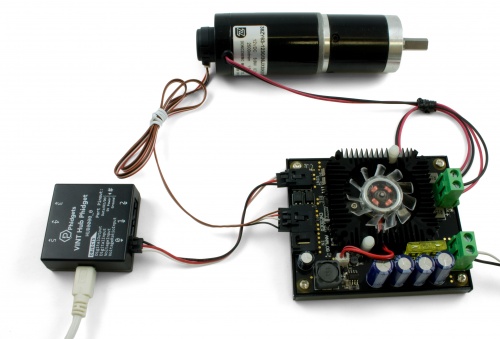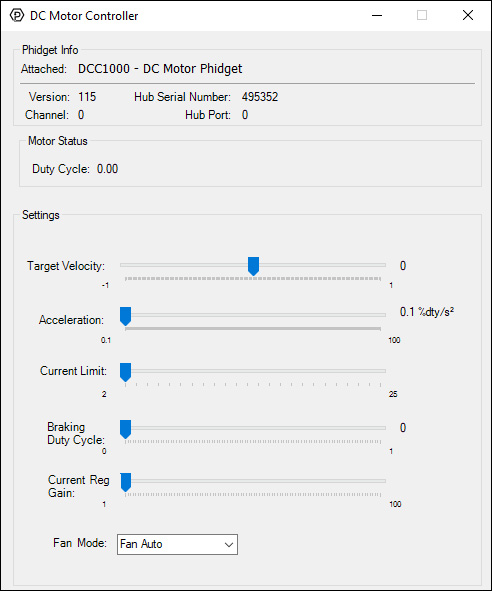DCC1000 User Guide: Difference between revisions
No edit summary |
|||
| Line 25: | Line 25: | ||
{{UGcontrolpanel|DCC1000}} | {{UGcontrolpanel|DCC1000}} | ||
{{ | {{ugDCMotor|DCC1000|DC Motor Phidget}} | ||
==Technical Details== | ==Technical Details== | ||
? | |||
=== Further Reading === | === Further Reading === | ||
For more information, have a look at the [[ | For more information, have a look at the [[DC Motor and Controller Primer]]. | ||
{{UGnext|}} | {{UGnext|}} | ||
Revision as of 20:20, 15 August 2017
Getting Started
Welcome to the DCC1000 user guide! In order to get started, make sure you have the following hardware on hand:
- DCC1000 DC Motor Phidget
- VINT Hub
- Phidget cable
- USB cable and computer
- Power supply (8-30V DC)
- DC motor
Next, you will need to connect the pieces:

- Connect the DCC1000 to the VINT Hub using the Phidget cable.
- Connect the motor to the Phidget's output terminals.
- Connect the VINT Hub to your computer with a USB cable.
- (Optional) If your motor has an encoder, connect it to the encoder port on the DCC1000.
- Connect the power supply to the power terminals.
Now that you have everything together, let's start using the DCC1000!
Using the DCC1000
Phidget Control Panel
In order to demonstrate the functionality of the DCC1000, the Phidget Control Panel running on a Windows machine will be used.
The Phidget Control Panel is available for use on both macOS and Windows machines.
Windows
To open the Phidget Control Panel on Windows, find the ![]() icon in the taskbar. If it is not there, open up the start menu and search for Phidget Control Panel
icon in the taskbar. If it is not there, open up the start menu and search for Phidget Control Panel
macOS
To open the Phidget Control Panel on macOS, open Finder and navigate to the Phidget Control Panel in the Applications list. Double click on the ![]() icon to bring up the Phidget Control Panel.
icon to bring up the Phidget Control Panel.
For more information, take a look at the getting started guide for your operating system:
Linux users can follow the getting started with Linux guide and continue reading here for more information about the DCC1000.
First Look
After plugging the DCC1000 into your computer and opening the Phidget Control Panel, you will see something like this:

The Phidget Control Panel will list all connected Phidgets and associated objects, as well as the following information:
- Serial number: allows you to differentiate between similar Phidgets.
- Channel: allows you to differentiate between similar objects on a Phidget.
- Version number: corresponds to the firmware version your Phidget is running. If your Phidget is listed in red, your firmware is out of date. Update the firmware by double-clicking the entry.
The Phidget Control Panel can also be used to test your device. Double-clicking on an object will open an example.
DC Motor
Double-click on the DC Motor object, labelled DC Motor Phidget, in order to run the example:

General information about the selected object will be displayed at the top of the window. You can also experiment with the following functionality:
- Toggle the BackEMF Sensing checkbox to enable/disable back-EMF sensing on the DCC1000.
- Drag the Target Velocity slider from -1 (full reverse) to 1 (full forward) to make the motor move.
- Manipulate the Acceleration slider to increase/decrease the amount of time it takes the DC Motor to reach a target velocity.
Technical Details
?
Further Reading
For more information, have a look at the DC Motor and Controller Primer.
What to do Next
- Programming Languages - Find your preferred programming language here and learn how to write your own code with Phidgets!
- Phidget Programming Basics - Once you have set up Phidgets to work with your programming environment, we recommend you read our page on to learn the fundamentals of programming with Phidgets.
